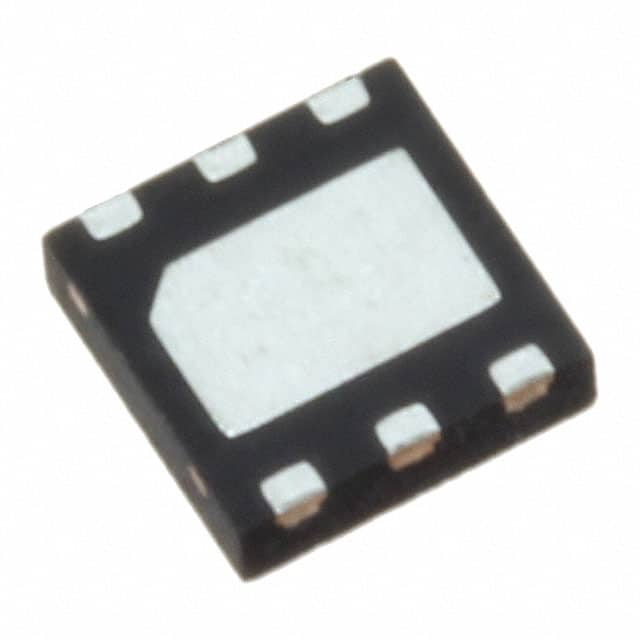MAX16059ATT26+T
Product Overview
- Category: Integrated Circuits
- Use: Voltage Supervisors
- Characteristics: Low-Power, Single/Dual/Triple Voltage Monitors with Manual Reset Input
- Package: Thin SOT23-6
- Essence: This product is a voltage supervisor integrated circuit designed to monitor the power supply voltage of electronic systems and provide reset signals when the voltage falls below or rises above certain thresholds.
- Packaging/Quantity: The MAX16059ATT26+T is available in tape and reel packaging with 3000 units per reel.
Specifications
- Supply Voltage Range: 1.6V to 5.5V
- Operating Temperature Range: -40°C to +125°C
- Reset Threshold Options: 2.6V, 3.08V, 4.63V (selectable)
- Manual Reset Input: Active-Low, Push-Pull Output
- Quiescent Current: 1.5µA (typical)
Pin Configuration
The MAX16059ATT26+T has a total of 6 pins arranged as follows:
```
| | --| VCC GND |-- Pin 1: Ground (GND) --| MR RST |-- Pin 2: Manual Reset Input (MR) --| RST VCC |-- Pin 3: Power Supply (VCC) --| RESET OUT |-- Pin 4: Reset Output (RESET OUT) --| GND VCC |-- Pin 5: Ground (GND) |___________| ```
Functional Features
- Monitors the power supply voltage and generates a reset signal when it falls below or rises above the user-defined thresholds.
- Provides manual reset capability through the MR pin.
- Low quiescent current consumption, making it suitable for battery-powered applications.
- Push-pull output for the manual reset signal.
Advantages
- Wide supply voltage range allows compatibility with various electronic systems.
- Selectable reset threshold options provide flexibility in different applications.
- Low quiescent current helps conserve power in battery-operated devices.
- Manual reset input offers additional control over system reset functionality.
- Small package size enables space-efficient designs.
Disadvantages
- Limited number of reset threshold options may not meet the requirements of all applications.
- Lack of built-in hysteresis may result in potential noise-related issues in certain scenarios.
Working Principles
The MAX16059ATT26+T operates by continuously monitoring the power supply voltage. When the voltage falls below or rises above the user-defined thresholds, the integrated circuit generates a reset signal on the RESET OUT pin. The manual reset input (MR) allows the user to manually trigger a reset signal regardless of the monitored voltage level. The low quiescent current ensures minimal power consumption when the device is in operation.
Application Field Plans
The MAX16059ATT26+T can be used in various applications where voltage supervision and reset functionality are required. Some potential application fields include:
- Microcontroller-based Systems: Ensuring proper system initialization and reliable operation by monitoring the power supply voltage.
- Battery-Powered Devices: Preventing damage to sensitive components by generating a reset signal when the battery voltage drops below a safe threshold.
- Industrial Control Systems: Providing a reliable reset mechanism to ensure stable operation of critical equipment.
- Automotive Electronics: Monitoring the vehicle's power supply voltage and triggering a reset if necessary to prevent malfunctions.
Alternative Models
- MAX16058ATT26+T: Similar to MAX16059ATT26+T but with different reset threshold options.
- MAX16060ATT26+T: Voltage supervisor with additional features such as adjustable reset timeout and watchdog timer.
- MAX16061ATT26+T: Dual voltage supervisor with independent manual reset inputs for each monitored voltage.
These alternative models offer similar functionality but may have different specifications or additional features to cater to specific application requirements.
Word count: 536 words
Senaraikan 10 soalan dan jawapan biasa yang berkaitan dengan aplikasi MAX16059ATT26+T dalam penyelesaian teknikal
Sure! Here are 10 common questions and answers related to the application of MAX16059ATT26+T in technical solutions:
Q: What is the MAX16059ATT26+T? A: The MAX16059ATT26+T is a low-power, voltage-monitoring circuit designed for use in various technical solutions.
Q: What is the purpose of the MAX16059ATT26+T? A: The purpose of the MAX16059ATT26+T is to monitor voltage levels and provide accurate power supply monitoring in electronic systems.
Q: How does the MAX16059ATT26+T work? A: The MAX16059ATT26+T works by comparing the monitored voltage level with a user-defined threshold and generating an output signal when the voltage exceeds or falls below the threshold.
Q: What is the operating voltage range of the MAX16059ATT26+T? A: The operating voltage range of the MAX16059ATT26+T is typically between 1.6V and 5.5V.
Q: Can the MAX16059ATT26+T be used in battery-powered applications? A: Yes, the MAX16059ATT26+T is suitable for battery-powered applications due to its low-power consumption.
Q: Does the MAX16059ATT26+T have any built-in hysteresis? A: Yes, the MAX16059ATT26+T features programmable hysteresis, allowing users to set the desired level of voltage difference required to trigger the output.
Q: What is the output configuration of the MAX16059ATT26+T? A: The MAX16059ATT26+T provides an open-drain output, which can be easily interfaced with other digital circuits.
Q: Can the MAX16059ATT26+T be used for overvoltage and undervoltage protection? A: Yes, the MAX16059ATT26+T can be configured to provide both overvoltage and undervoltage protection by setting appropriate threshold levels.
Q: Is the MAX16059ATT26+T suitable for automotive applications? A: Yes, the MAX16059ATT26+T is automotive-grade and can be used in various automotive systems that require voltage monitoring.
Q: What are some typical applications of the MAX16059ATT26+T? A: The MAX16059ATT26+T can be used in a wide range of applications, including power management systems, battery chargers, industrial control systems, and portable devices.
Please note that these answers are general and may vary depending on specific requirements and use cases.


